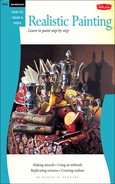THE AIRBRUSH
There are four essential elements for airbrushing—an airbrush, air hose, compressor, and paint. Your budget will dictate your selections. Keep in mind that when properly cared for, good-quality supplies will last a lifetime.
The airbrush is a small pen-sized tool that uses compressed air to spray paint. It was invented in 1893 by Charles Burdick, whose original intention was to use it for watercolor painting. It became popular, however, for photo retouching and, for many years, continued to be used mainly in the graphic arts field. Only in the past 40 years has the airbrush entered into a new major role as a tool for the fine artist. The airbrush is an excellent tool for artists who want to expand their working capabilities. It extends the possibilities and effects of any medium that can be sprayed through it. There are some effects—such as fog, controlled spattering, delicate blendings, glazes with watercolor—that would be impossible to achieve without the airbrush.
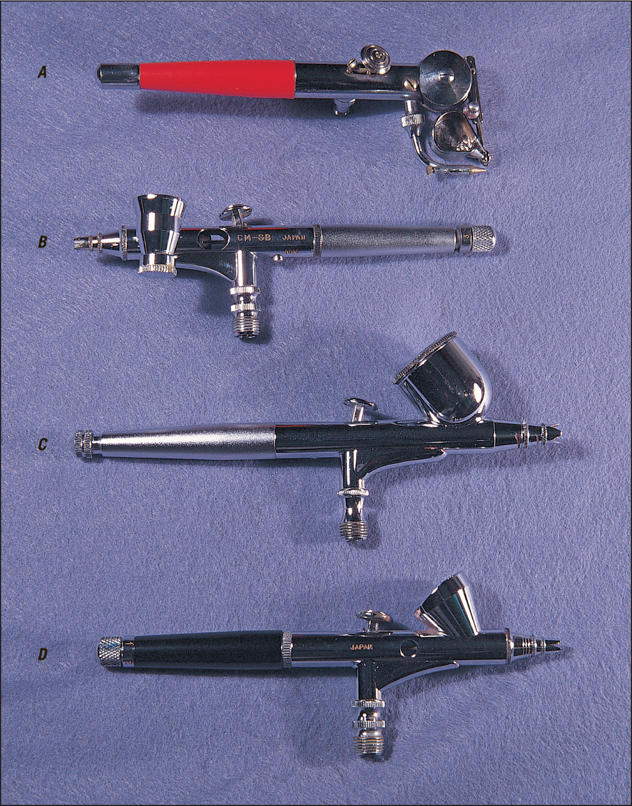
AIRBRUSHES (A) Oscillating model—provides the finest spray; (B) Side cup, double-action model—allows for quick color changes; (C) Large, gravity-fed cup model—holds a lot of paint; (D) Gravity-fed model—has a very fine spray.
SINGLE ACTION VS. DOUBLE ACTION
Single action and double action describe the trigger controls of the airbrush. An airbrush is either one or the other (except for the oscillating type, which is in a category by itself). With a single-action model, both air and paint come out when you press down on the trigger. The paint spray is changed by adjusting the screw on the back of the handle (on some models). You have to stop painting to adjust the amount of spray. With a double-action model, when you push down on the trigger you get air, and by pushing down and pulling back, you get air and paint. The farther back you pull, the more paint you get. The double-action airbrush is preferred because it provides more control.
EXTERNAL MIX VS. INTERNAL MIX
With an external-mix airbrush, air and paint are mixed (atomization) outside the body of the airbrush. With an internal-mix model, they are mixed inside the body. The internal mix is recommended because it creates a much finer spray and does not create large dots of paint. The external-mix models have a grittier spray. In general, less-expensive hobby airbrushes are external mix. All professional, double-action airbrushes are internal mix.
HOW TO START AIRBRUSHING
The airbrush should be advanced enough that you can grow into it. Again, a double-action, internal-mix model is recommended. The air hose is necessary to give pressure to the airbrush. Purchase whatever type is recommended for your airbrush and compressor. The compressor is the most important consideration. You will airbrush at 20–30 pounds per square inch (PSI). PSI is the pressure at which air flows through the airbrush. If the pressure is too high, the paint will be hard to control; if too weak, the paint will hardly come out. A good compressor will have a pressure regulator that automatically keeps the air pressure constant. For paint, you will use thinned gouache. It should be the consistency of milk—or slightly heavier. If it is too thick, it will come out in spatters; if too thin, it will run.
COMPRESSORS AND AIR SOURCES
Compressors are the most popular sources of air power. Run by small motors that range from 1/16- to 1/2-horse power, they run either “silently” or continuously. A silent compressor has a storage tank; when it reaches the proper PSI, it shuts off. You can spray in silence until the pressure drops and the motor has to maintain the pressure. The smaller, continuous-running compressors are noisy and not as powerful. The silent compressor is the most expensive model but highly recommended for a lifetime of use. Some of the larger compressors are oil free, which are maintenance free and also highly recommended.
Another type of air source is the CO2 tank. These are large tanks of compressed carbon dioxide. They last for quite a while but eventually have to be refilled. They can be refilled at scuba or party supply shops. Many art studios prefer CO2 tanks because they are so quiet.
The third option—but not a practical one—is the “canned air” sold at art stores. Canned air is quite expensive for what you get. The pressure in one can of air will probably not last long enough for one major project.
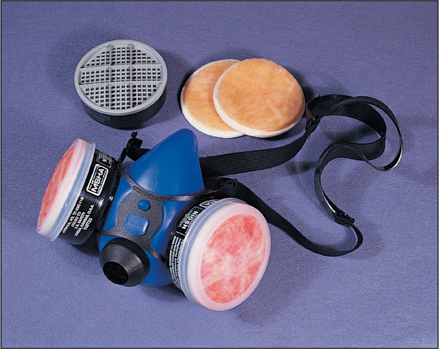
RESPIRATORS You must protect your lungs while airbrushing. Paint can ricochet off the support and become airborne. Hence, the necessity of a respirator. A respirator fits over your mouth and nose and filters out minute particles of paint. There are different kinds of filters available. The more expensive types have charcoal filters and filtering pads so they are especially safe.
AIRBRUSHING EXERCISES
Using the airbrush is not difficult, but it requires practice to master. Each of these exercises is designed for a specific skill. Practice each exercise daily and you will become proficient.
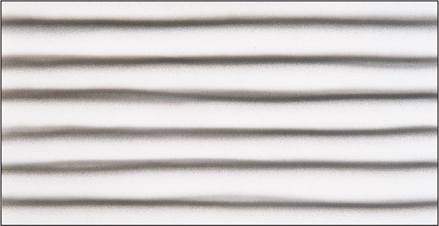
PARALLEL LINES Practicing parallel lines freehand is important for line control. Practice the motion of keeping the lines from touching each other and making them consistent in thickness.
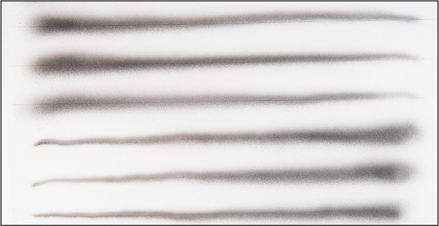
VARYING LINES In this exercise, begin spraying the line while holding the tool close to the paper. As you continue, gradually pull the airbrush farther away, creating a thicker, softer line.

VARYING DOTS The farther away the airbrush is from the paper, the larger the spray. Make large dots at the top, medium dots in the middle, and small dots at the bottom.
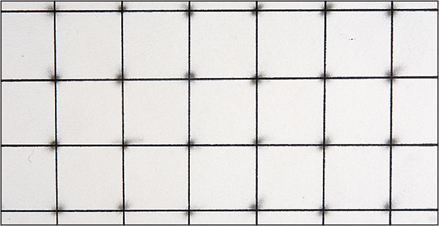
CONSISTENT DOTS Try making dots of the same size at each intersection of the grid. When you can make the same-sized dots, you will know that you have good control of the airbrush.
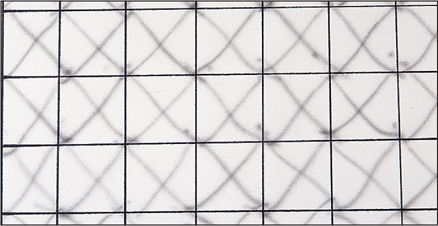
MAKING XS Making Xs across the paper will test your eye–hand coordination and ability to make even stroke lines with a quick stop. Remember, the end result is not as important as testing the capabilities of the airbrush.

CURLICUES AND CURSIVE WRITING Making curlicues and writing in cursive are good techniques for developing coordination. Smooth, curved lines require good airbrush control.
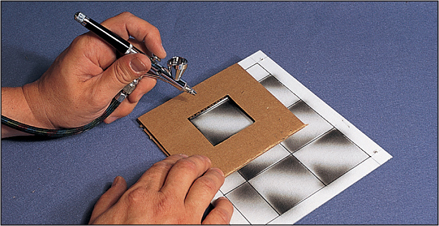
METALLIC EFFECT 1 To create a metallic effect, first cut a 2” square stencil out of cardboard. Then place the stencil over the paper and spray black gouache at a diagonal in two opposite corners.
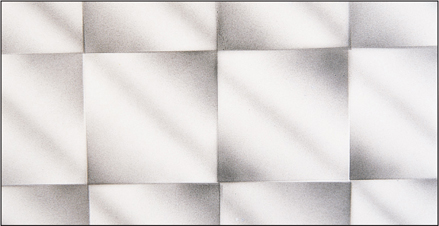
METALLIC EFFECT 2 There should be a light strip of plain paper left in the middle of each square. When you are finished with the exercise, the paper should look like a panel of metallic squares.
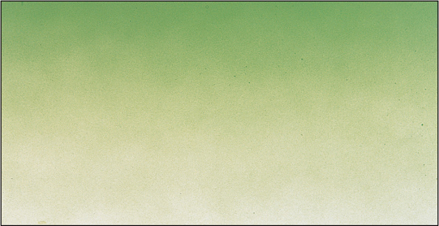
GRADUATED COLOR Spraying a graduated color from top to bottom—or vice versa—is a technique used to create backgrounds, skies, or anything that requires gradual blending.
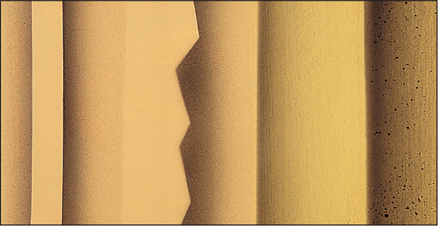
HARD EDGES Create hard edges by placing various objects directly on the paper. Here, drafting tape, a piece of paper, a ruler, and a piece of cardboard have been used to create hard edges.
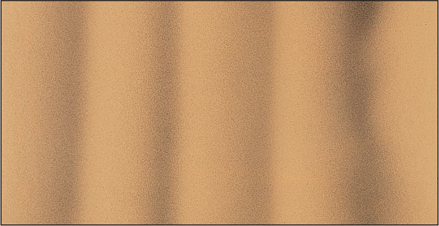
SOFT EDGES You can achieve soft edges by spraying over items that are elevated off the paper. The overspray softens the edges. Use paper, rulers, cardboard, or cotton to create soft edges.
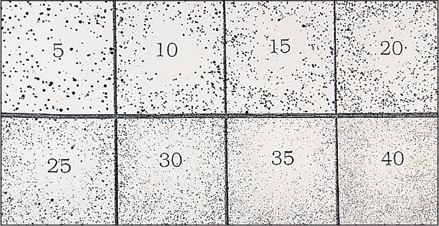
SPATTERING The dot size of the spray depends on the PSI setting. The lower the pressure, the larger the dot pattern. Note: This effect can only be done with airbrushes that have a spatter capability.
